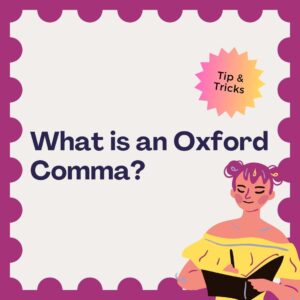What is an Oxford Comma and When Do You Use It? Definition & Examples
The Oxford comma, also known as the serial comma, is a punctuation mark that has sparked considerable debate among writers, editors, and grammarians. This guide will explore what the Oxford comma is, its importance in writing when to use it, and how it can affect clarity in your sentences. By the end of this article, you will have a thorough understanding of the Oxford comma and be equipped to use it effectively in your writing.

Table of Contents
Definition of the Oxford Comma
The Oxford comma is a comma placed before the conjunction (usually “and” or “or”) in a list of three or more items. For example:
- With Oxford Comma: “I would like to thank my parents, Oprah Winfrey, and God.”
- Without Oxford Comma: “I would like to thank my parents, Oprah Winfrey and God.”
In the first example, the use of the Oxford comma clarifies that there are three distinct entities being thanked.
History of the Oxford Comma
The term “Oxford comma” is derived from its usage by the Oxford University Press, which has advocated for its use since at least 1905. The practice was popularized by Horace Hart, who wrote Hart’s Rules for Compositors and Readers, a style guide for typesetters at the press.Historically, commas have been used to separate items in lists since punctuation was first standardized in English writing. The introduction of the serial comma helped clarify complex lists and prevent ambiguity.
Importance of the Oxford Comma
The primary purpose of the Oxford comma is to enhance clarity in writing. It serves several important functions:
- Prevents Ambiguity: Without the Oxford comma, sentences can be misinterpreted or confusing.
- Improves Readability: Lists are easier to read and understand when each item is clearly delineated.
- Establishes Consistency: Using the Oxford comma consistently throughout your writing helps maintain a professional tone.
Example:
Consider this sentence without an Oxford comma:
- “I love my parents, Lady Gaga and Elvis Presley.”
This could imply that Lady Gaga and Elvis Presley are your parents. Adding an Oxford comma clarifies:
- “I love my parents, Lady Gaga, and Elvis Presley.”
When to Use the Oxford Comma
You should use the Oxford comma in lists that contain three or more items when clarity is needed. Here are some specific scenarios:
- Complex Lists: When items in your list contain conjunctions themselves.
- Example: “We visited Paris, France; London, England; and Rome, Italy.”
- Avoiding Misinterpretation: When omitting the comma could lead to confusion.
- Example: “To my friends, John and Jane.” vs. “To my friends, John, and Jane.”
- Formal Writing: In academic or professional contexts where clarity is paramount.
General Rule:
If you can logically include an item in a list without changing its meaning when using an additional conjunction (like “and”), consider using an Oxford comma.
Examples of the Oxford Comma
Here are several examples illustrating both uses:
With Oxford Comma:
- “For breakfast, I had eggs, toast, and coffee.”
- “The committee includes Sarah, Tom, and Jane.”
- “We need milk, bread, and cheese.”
Without Oxford Comma:
- “For breakfast, I had eggs, toast and coffee.” (This could imply toast and coffee are one item.)
- “The committee includes Sarah, Tom and Jane.” (This may confuse readers about whether Tom and Jane are grouped together.)
- “We need milk, bread and cheese.” (Less clear than with an Oxford comma.)
Common Misconceptions About the Oxford Comma
Several misconceptions surround the use of the Oxford comma:
- It’s Optional: While technically optional according to some style guides, many recommend using it for clarity.
- It’s Always Necessary: Some argue that it’s not needed if there’s no ambiguity; however, including it can prevent future misunderstandings.
- It’s Just a Style Choice: While personal preference plays a role, clarity should always be prioritized in writing.
Style Guides and the Oxford Comma
Different style guides have varying recommendations regarding the use of the Oxford comma:
- APA Style: Recommends using it consistently for clarity.
- MLA Style: Also advocates for its use in lists.
- Chicago Manual of Style: Supports using it as well.
- Associated Press (AP) Style: Generally advises against using it unless necessary for clarity.
Summary Table:
| Style Guide | Recommendation on Oxford Comma |
|---|---|
| APA | Use it |
| MLA | Use it |
| Chicago Manual | Use it |
| AP Style | Avoid unless necessary |
The Debate: To Use or Not to Use?
The debate over whether to use the Oxford comma often centers around clarity versus brevity:
- Proponents argue that it prevents ambiguity and enhances understanding.
- Opponents claim that it can clutter writing unnecessarily.
Ultimately, your choice may depend on your audience or specific style guide you are following.
Practical Tips for Using the Oxford Comma
To effectively incorporate the Oxford comma into your writing:
- Be Consistent: Choose whether you will use it or not throughout your document.
- Consider Your Audience: If you’re writing for a formal audience or publication that requires clarity (like academic papers), lean towards using it.
- Read Aloud: Hearing your sentences can help you determine if adding an Oxford comma improves clarity.
FAQs
1. What is the Oxford comma?
The Oxford comma, also known as the serial comma, is a comma placed before the final conjunction (usually “and” or “or”) in a list of three or more items. For example, in the sentence “I bought apples, oranges, and bananas,” the comma before “and” is the Oxford comma.
2. Why is it called the Oxford comma?
The term “Oxford comma” comes from its strong association with the style guide of Oxford University Press, which has recommended its use since the early 20th century. It is also referred to as a serial comma or Harvard comma due to its usage in various academic contexts.
3. Is the Oxford comma necessary?
The Oxford comma is optional; however, its use is often recommended for clarity. In some cases, omitting it can lead to ambiguity or misinterpretation of a sentence. For example, “I love my parents, Lady Gaga and God” could imply that Lady Gaga and God are the speaker’s parents without the Oxford comma.
4. Can you provide examples of when to use the Oxford comma?
Certainly! Here are examples demonstrating its use:
- With Oxford Comma: “For breakfast, I had eggs, toast, and orange juice.”
- Without Oxford Comma: “For breakfast, I had eggs, toast and orange juice.”
In this case, both sentences are grammatically correct, but the first one provides clearer separation between items.
5. What are the arguments for using the Oxford comma?
Proponents argue that the Oxford comma enhances clarity by clearly delineating items in a list. It can prevent misunderstandings in complex lists where items may be misinterpreted without it. For instance:
- Without Oxford Comma: “I would like to thank my parents, Oprah Winfrey and God.”
- With Oxford Comma: “I would like to thank my parents, Oprah Winfrey, and God.”
The second sentence makes it clear that three distinct entities are being thanked.
6. Are there style guides that recommend using the Oxford comma?
Yes, many academic style guides—including APA and Chicago—recommend using the Oxford comma for clarity and consistency. However, some style guides, such as AP (Associated Press), advise against its use unless necessary for clarity.
7. How does the use of the Oxford comma change meaning?
The presence or absence of the Oxford comma can change how a sentence is interpreted. For example:
- Without: “We invited the strippers, JFK and Stalin.”
- With: “We invited the strippers, JFK, and Stalin.”
In the first sentence, it may appear that JFK and Stalin are being referred to as strippers without the comma.
8. Is it acceptable to omit the Oxford comma in informal writing?
While it’s generally acceptable to omit the Oxford comma in informal writing or personal communication, maintaining consistency throughout your writing is important. If you choose to use it in some instances, be sure to do so consistently across your document.
9. How can I decide whether to use the Oxford comma?
Your decision should depend on your audience and purpose:
- If you’re following a specific style guide that mandates its use (like APA), include it.
- If you’re writing informally or for an audience that prefers brevity (like news articles), you might choose to omit it.
- Always prioritize clarity; if omitting it could lead to confusion, it’s better to include it.
10. What should I do if I’m unsure about using the Oxford comma?
If you’re unsure about using the Oxford comma:
- Refer to relevant style guides applicable to your writing context.
- Consider your audience’s preferences.
- When in doubt about potential ambiguity in your lists, opt for clarity by including the Oxford comma.
Conclusion
The Oxford comma is a valuable tool for writers seeking to enhance clarity in their writing. By understanding its definition, importance, and proper usage, you can avoid common pitfalls associated with ambiguous lists. Whether you choose to adopt this punctuation mark depends on your writing style and audience preferences; however, prioritizing clarity should always be your guiding principle . By mastering the use of the Oxford comma along with other punctuation rules, you will improve your overall writing skills and communicate more effectively with your readers.




